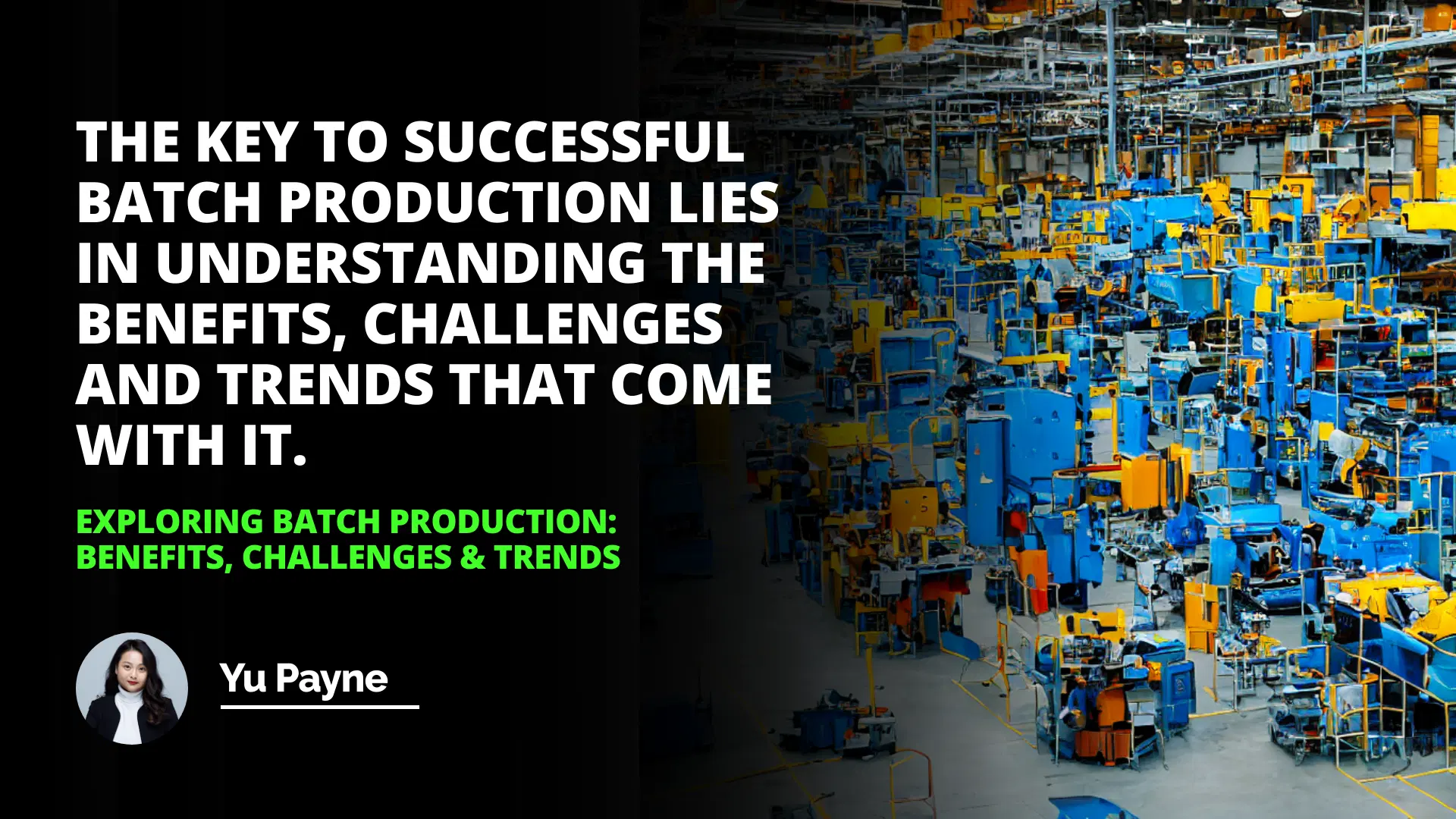
Definition of Batch Production
Benefits of Batch Production
Challenges of Batch Production
Applications of Batch Production in Logistics Management
Future Trends in Batch Production and Logistics Management
Batch production is an effective manufacturing process combining the benefits of mass production and job production methods. It is a production method where a series of partially completed products are produced in batches; each made to the exact specification to achieve maximum efficiency. This production method is widely used by companies in many different industries, including automotive, electronics, and logistics. In this blog post, we will explore the benefits and challenges of batch production and discuss the applications of batch production in logistics management and the future trends in batch production and logistics management.
Definition of Batch Production
Batch production is a method whereby a series of partially completed products are produced in batches, each made to the exact specification. This production method is beneficial because it combines the benefits of both mass production and job production methods, aiming to achieve maximum efficiency.
Benefits of Batch Production
The primary benefit of batch production is that it is a more cost-effective option than mass production. By producing multiple items in a single batch rather than individually, companies can take advantage of economies of scale and thus reduce their production costs. Additionally, batch production allows companies to adjust their production runs to meet changing market demands quickly.
Another benefit of batch production is that it allows for more flexibility in the production process. By producing multiple items in a single batch, companies can respond quickly to changes in customer demand or market conditions. Additionally, batch production allows companies to produce various products in a single production run, thus increasing the range of produced products.
Finally, batch production is also more efficient than traditional mass production. By producing multiple items in a single batch, companies can reduce their production times and thus increase their productivity. Furthermore, batch production reduces the amount of waste generated during manufacturing, as the exact specification is used for every batch.
Challenges of Batch Production
Despite the many benefits of batch production, it has its challenges. One of the main challenges of batch production is that it requires significant planning and coordination. Companies must carefully plan and coordinate their production runs to ensure each batch is made to the exact specification. Additionally, batch production can be challenging to scale up, as the production process must be adjusted to accommodate larger batches.
Another challenge of batch production is that it can take time to ensure quality control. As each batch is made to the exact specification, ensuring that each batch's quality is consistent can be challenging. Additionally, it can be challenging to ensure that each batch is produced promptly, as delays in one batch can cause delays in the entire production process.
Applications of Batch Production in Logistics Management
Batch production is increasingly used in logistics management due to its many benefits. By producing multiple items in a single batch, companies can reduce their production times and thus reduce their delivery times. Additionally, batch production allows companies to quickly adjust their production runs to meet changing market demands, thus ensuring that they always have the right items in stock. Finally, batch production also allows companies to reduce their warehousing costs, as they can store multiple items in a single warehouse space.
Future Trends in Batch Production and Logistics Management
The future of batch production and logistics management will likely see greater automation and technology integration. Companies increasingly turn to automated production systems to improve their production processes and reduce costs. Companies are also turning to advanced technologies such as artificial intelligence (AI) and the Internet of Things (IoT) to improve their production processes further and optimize their logistics management. Finally, companies are also investing in predictive analytics to predict customer demand better and thus reduce their costs.
Conclusion: In conclusion, batch production is an effective manufacturing process combining the benefits of mass production and job production methods. It is a cost-effective option that allows companies to adjust their production runs quickly to meet changing market demands. Batch production is also increasingly used in logistics management due to its many benefits. Finally, the future of batch production and logistics management will likely see greater automation and technology integration. Companies invest in advanced technologies such as AI and the IoT to improve their production processes and optimize logistics management.
The key to successful batch production lies in understanding the benefits, challenges, and trends that come with it.
Frequently Asked Questions
What are the benefits of batch production?
Batch production is a method of manufacturing that involves producing multiple units of a product simultaneously. This production method has been in use for centuries and remains popular today due to its many benefits.
One significant benefit of batch production is that it allows for economies of scale, meaning that the cost per unit decreases as more units are produced in each batch. This is because certain fixed costs, such as setup or machine maintenance, are spread out over multiple units rather than just one unit. This can lead to significant savings when dealing with large-scale manufacturing projects.
Another advantage of batch production is that it can significantly reduce labor costs since fewer workers are needed to manage the entire process. In addition, with batch production, tasks such as setup and quality control can be automated, allowing fewer workers to take care of the entire process while maintaining high-quality control and efficiency levels. This makes the entire process more cost-effective and productive overall.
Batch production also helps reduce waste by ensuring that only the necessary resources are used during each cycle. By setting specific parameters for each cycle, such as the number of parts needed or material type required, manufacturers can ensure they produce only a little in any given cycle leading to less waste overall.
Finally, batch production gives manufacturers greater flexibility when dealing with rapidly changing customer preferences or new product introductions. They can quickly adjust their processes without stopping the entire operation and start from scratch whenever something needs to be changed. This makes it easier for manufacturers to stay competitive in rapidly changing markets where customers’ needs change quickly and often.
In conclusion, batch production offers numerous benefits that make it an attractive option for many manufacturers looking to remain competitive while reducing costs and waste associated with their operations. For example, it allows for economies of scale by spreading fixed costs over multiple units; reduces labor costs by automating specific tasks; reduces waste by ensuring only necessary resources are used; and gives manufacturers greater flexibility when dealing with changing customer preferences or new product introductions.
How does batch production compare to mass production?
Batch and mass production are two primary production techniques in the manufacturing industry. Batch production is an economical method that involves producing a limited number of parts or products at one time. It is generally used for small-scale production and is suitable for products requiring more customization. Mass production, on the other hand, is an efficient method of production that involves producing a large number of parts or products in one go. Therefore, it suits products requiring less customization and can be used for large-scale production.
When comparing batch production to mass production, it is essential to consider the advantages and disadvantages of each technique. Batch production is cost-effective as it requires less upfront capital investment in equipment and materials. It also allows for more customization, which benefits products requiring more personalization. Additionally, batch production allows for better quality control as each batch can be individually tested and inspected.
The main disadvantage of batch production is that it is unsuitable for high-volume production. The process is time-consuming and labor-intensive, and the cost of producing a batch of products can be relatively high, making it unsuitable for large-scale production.
On the other hand, mass production is an efficient and cost-effective production method. It allows for large-volume production, making it suitable for large-scale production. The automated process reduces labor costs and speeds up production time. Mass production also allows for better standardization of parts and products, leading to improved quality control.
The main disadvantage of mass production is that it only allows for a small quantity of customization. The process is automated, and the products are produced in large volumes, which means that the products are all essentially the same. This can be problematic for products that require more personalization.
In conclusion, both batch and mass production have advantages and disadvantages. Each method should be considered carefully when determining the best production technique for a particular product or project. Batch production is suitable for small-scale production and products that require more customization, while mass production is suitable for large-scale production and products that require less customization.
What are the trends in batch production and logistics management?
The trends in batch production and logistics management are rapidly evolving due to technological advancements. Batch production, which is the practice of producing a given quantity of products at one time, is becoming increasingly popular as it helps to reduce costs and increases efficiency. Additionally, with the emergence of Industry 4.0 and its associated technologies, batch production has become even more sophisticated. As a result, the need for effective logistics management has also increased significantly.
Logistics management refers to coordinating physical products and information in supply chain operations. It includes ordering processing, inventory control, warehousing, transportation management, packaging, and labeling. In order to ensure efficient batch production processes and successful logistics management strategies, companies must consider various factors such as product availability, cost-effectiveness, and customer satisfaction.
One of the significant trends in batch production and logistics management is automation. Automation involves using machines or systems to complete tasks that would otherwise be completed manually. Automation can reduce costs by increasing efficiency while ensuring accuracy in product output. Additionally, automated machines can be designed to handle different types of products with varying levels of complexity. This increases flexibility for companies in manufacturing batches with different specifications or requirements at different times. Moreover, automated systems can provide real-time data that can be used for better decision-making purposes related to inventory control or product delivery times which further enhances efficiency within a company’s supply chain operations.
Another significant trend is using Big Data analytics tools for better decision-making processes related to batch production and logistics management operations within an organization’s supply chain network. Analytics tools allow companies to analyze large amounts of data from multiple sources (e-commerce platforms such as Amazon or eBay; social media platforms such as Facebook or Twitter; market research reports; etc.) so they can identify patterns that might not have been visible before which can lead them towards more effective decisions when it comes down to managing their resources better (for instance by determining how many resources should be allocated towards specific projects).
Finally, there is an increasing emphasis on sustainability within this context, too, where companies need to ensure they are following environmentally friendly practices while implementing their batch production processes (such as using renewable energy sources wherever possible) alongside utilizing green technologies when it comes down towards developing efficient logistics strategies (such as using electric vehicles instead of conventional ones). Furthermore, companies should also strive towards reducing their carbon footprint by minimizing waste whenever possible during both manufacturing and transportation processes so they can remain competitive in today’s market while aligning themselves with established regulations regarding environmental protection policies at the same time.
In conclusion, businesses must consider various trends related to batch production and logistics management if they want to remain competitive in today’s market. By leveraging automation, utilizing big data analytics tools effectively, and emphasizing sustainability during all stages of their supply chain operations, companies will have all the necessary resources available so they can operate efficiently while reducing costs whenever possible.


